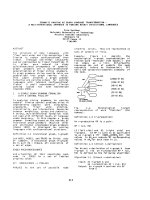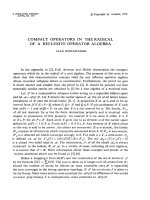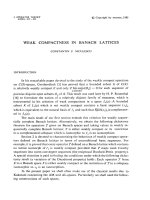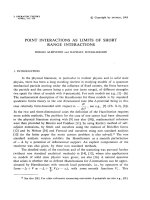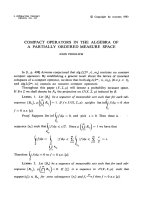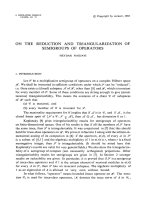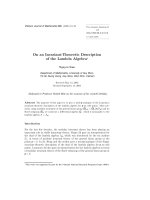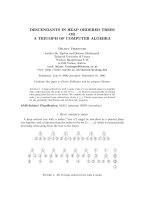Báo cáo toán học: " et another distance-regular graph related to a Golay code" ppsx
Bạn đang xem bản rút gọn của tài liệu. Xem và tải ngay bản đầy đủ của tài liệu tại đây (72.07 KB, 4 trang )
Yet another distance-regular graph related
to a Golay code
Leonard H. Soicher
School of Mathematical Sciences
Queen Mary and Westfield College
Mile End Road, London E1 4NS, U.K.
email:
Submitted: January 20, 1995; Accepted: January 22, 1995
Abstract
We describe a new distance-regular, but not distance-transitive,
graph. This graph has intersection array
{
110
,
81
,
12; 1
,
18
,
90
}
,and
automorphism group
M
22
:2.
In [1], Brouwer, Cohen and Neumaier discuss many distance-regular graphs
related to the famous Golay codes. In this note, we describe yet another such
graph.
Ivanov, Linton, Lux, Saxl and the author [4] have classified all primitive
distance-transitive representations of the sporadic simple groups and their
automorphism groups. As part of this work, all multiplicity-free primitive
representations of such groups have also been classified. One such represen-
tation is M
22
: 2 on the cosets of L
2
(11): 2. This representation has rank 6,
with subdegrees 1, 55, 55, 66, 165, 330. Let Γ be the graph obtained by the
edge-union of the orbital graphs corresponding to the two suborbits of length
1991 Mathematics Subject Classification: 05E30, 05C25
1
the electronic journal of combinatorics 2 (1995), #N1 2
55. By examining the sum
0550000
18401824
04120336
0 0 0 10 10 35
06142024
04671226
+
0055000
04120336
112003012
0 0 0102025
01108432
06251626
of the intersection matrices corresponding to these two orbital graphs, we see
that Γ is distance-regular, with intersection array
{110, 81, 12;1, 18, 90}.
According to [1, p.430], this graph was previously unknown.
We now give a description of Γ in terms of a punctured binary Golay
code. This description was obtained using the GRAPE share library package
[7] of the GAP system [6] (available from ftp.math.rwth-aachen.de).
Let C
22
be the code obtained by puncturing in one co-ordinate the (non-
extended) binary Golay code. Then C
22
is a [22, 12, 6]–code, with automor-
phism group M
22
:2. Let M be the set of the 77 minimum weight non-zero
words of C
22
,andV be the set of the 672 unordered pairs of words of weight
11 which have disjoint support. For v = {v
1
,v
2
}∈V define
M(v): = {m ∈ M | weight(v
1
+ m)=weight(v
2
+ m)}.
We remark that M (v) has size 55.
Now define Γ to have vertex set V , with vertices v, w joined by an edge
if and only if
|M(v) ∩ M(w)| =43.
We use GRAPE to check that Γ is indeed distance-regular, with intersection
array {110, 81, 12; 1, 18, 90}.Usingnauty [5] within GRAPE,wedetermine
that Aut(Γ)
∼
=
M
22
: 2, and so Γ is not distance-transitive.
Further computations reveal the following intriguing fact. Let v, w ∈ V ,
v = w.TheninΓ,wehave
d(v,w)=i
if and only if
|M(v) ∩ M(w)| =47− 4i.
the electronic journal of combinatorics 2 (1995), #N1 3
As noted in [1, p.430], the distance-2 graph Γ
2
is strongly regular, and it
has parameters
(v, k, λ,µ)=(672, 495, 366, 360).
Indeed, Γ
2
is a rank 3 graph for U
6
(2) (illustrating M
22
≤ U
6
(2)). The full
automorphism group of Γ
2
is U
6
(2): S
3
.
It would be interesting to have a natural computer-free proof of the results
in this note, and to see if these results generalize to other codes.
Remark A.A. Ivanov has since informed me that about ten years ago he
and his colleagues in Moscow discovered the four class association scheme
associated with the graph Γ (see [2, 3]), but they did not check this scheme
to determine if it came from a distance-regular graph.
References
[1] A.E. Brouwer, A.M. Cohen and A. Neumaier, Distance-Regular Graphs,
Springer, Berlin and New York, 1989.
[2] I.A. Faradzev, M.H. Klin and M.E. Muzichuk, Cellular rings and groups
of automorphisms of graphs, in Investigations in Algebraic Theory of
Combinatorial Objects (I.A.Faradzev,A.A.Ivanov,M.H.Klinand
A.J. Woldar, eds.), Kluwer Academic Publishers, 1994, pp. 1–153.
[3] A.A. Ivanov, M.H. Klin and I.A. Faradzev, Primitive representations
of nonabelian simple groups of order less than 10
6
,Part2,Preprint,
VNIISI, Moscow, 1984.
[4] A.A. Ivanov, S.A. Linton, K. Lux, J. Saxl and L.H. Soicher, Distance-
transitive representations of the sporadic groups, Comm. Algebra,to
appear.
[5] B.D. McKay, nauty user’s guide (version 1.5), Technical report TR-CS-
90-02, Computer Science Department, Australian National University,
1990.
[6] M. Sch¨onert, et. al., GAP – Groups, Algorithms and Programming,
fourth edition, Lehrstuhl D f¨ur Mathematik, RWTH Aachen, 1994.
the electronic journal of combinatorics 2 (1995), #N1 4
[7] L.H. Soicher, GRAPE: a system for computing with graphs and groups,
in Groups and Computation, L. Finkelstein and W.M. Kantor, eds., DI-
MACS Series in Discrete Mathematics and Theoretical Computer Sci-
ence 11, A.M.S., 1993, pp. 287–291.
